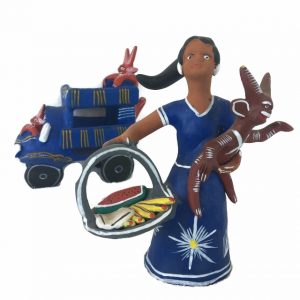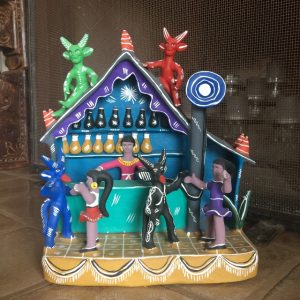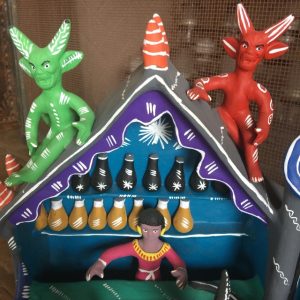That’s Ocumicho For You
 Ocumicho pottery is often an acquired taste. At first blush, you might even call it weird. It is brightly colored, executed in child-like form, but with a baudy and absurd humor about it. It is irreverent, poking fun at everything from sex and death, to religion and politics. Yet once you get it, YOU GET IT. Moreover, it gets you. One day, almost without warning, it comes home with you and you find it on your display shelf, front and center.
Ocumicho pottery is often an acquired taste. At first blush, you might even call it weird. It is brightly colored, executed in child-like form, but with a baudy and absurd humor about it. It is irreverent, poking fun at everything from sex and death, to religion and politics. Yet once you get it, YOU GET IT. Moreover, it gets you. One day, almost without warning, it comes home with you and you find it on your display shelf, front and center.
The art form originated in the small, dusty Michoacan village of Ocumicho, where pottery of a very conventional sort was made and sold by the women who lived there. However, in the 1950’s a man by the name of Marcelino Vicente put the Ocumicho pottery tradition on it’s ear. Instead of whimsical whistles and tidy little coin banks to sell to tourists, Vicente created wild figural tableaux, populated with devils, demons, and monsters of every stripe. The citizenry was appalled, but his work sold like hotcakes in the local markets. Eventually, he was “discovered,” by Francisco Mendoza, who worked for a government-sponsored art agency that specialized in encouraging folk artists and providing them wider access to large markets beyond their own villages. Mendoza gave Vicente his own gallery show in Mexico City and his distinctive Ocumicho sculptures got on the radar of collectors at home and abroad. A modest prosperity followed.
His success, however, came at a very high price. Not only was his art the object of jealousy within the village, the artist himself engendered controversy. Ocumicho was a very conservative, tradition-bound place, and Marcelino Vicente was anything but. His biographers have described him as a flamboyant cross-dresser, a homosexual, an unabashed narcissist, and an alcoholic. He became the victim of local thugs, who found him drinking alone in a bar late one evening and beat him savagely to death in 1968.
Fortunately, his artistic vision didn’t die with him in the bar that night. Coming from a large family, there are still plenty of relatives to keep his creative spirit alive and growing. Starting with locally harvested clays which have been painstakingly sifted to remove impurities, artists create their sculptures by hand, carefully molding and shaping the clay into devils, mermaids, soldiers, angels and beasts, who engage in activities ranging from dining at the Last Supper to flying helicopters. The sculptures are smoothed with a wet stone and then left to dry naturally, first in the shade, and later under the intense heat of full sun. Next, they are low-fired in circular kilns, and when cooled, are painted in rich, bright colors.
As humorously endearing as these sculptural scenes are, they are also very fragile. Great care must be taken in packing and shipping to minimize the risk of damage as much as possible. In consequence, those costs are necessarily high for us and for the end purchasers as well. It’s almost crazy to import and sell them at all, but then again, love makes us do crazy things. Are you crazy too?
Contributed by Linda for It’s Cactus


